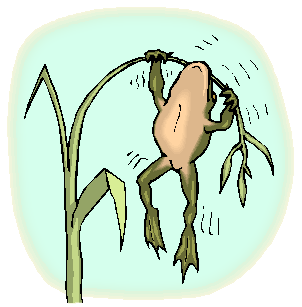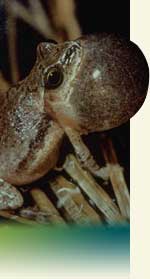Calling Frog Survey: About the Survey
Introduction
Welcome to the calling frog survey for Chicago Wilderness. Before the Calling Frog Survey began, very little was known about the distribution and status of amphibians within Chicago Wilderness. Not any more! The Calling Frog Survey is providing important information to scientists and land managers, who can use the data we collect to conduct management and research that benefits amphibian populations.
We are developing a regional profile of frog and toad species—their geographic distributions and relative abundances. This profile is possible only because of our network of dedicated frog monitors.
The volunteer "citizen scientists" who monitor the frogs and toads of Chicago Wilderness are the heart of the Calling Frog Survey program. Along with area scientists and land managers, we collect the data, analyze the results, and share what we've learned with the public. We thank you for participating, and we look forward to another fun, productive year of monitoring.

What Is A Calling Frog Survey?
A calling frog survey is a rather simple endeavor. Participants only need to learn the unique calls of the 13 species of frogs and toads that occur in the Chicago Wilderness region. Observers attend one educational meeting and then listen for frogs on three separate evenings in the spring, each lasting for about one to two hours. You will soon become amazed by the vast richness of amphibian life at night.
What Happens to the Data?
- Data from the Calling Frog Survey is first entered into an online database. You either enter the data yourself, or you send a handwritten copy to your county coordinator, who forwards it to the PNNM for data entry.
- The information is passed on to the appropriate land owning agency, such as the county forest preserve district, to aid in the land management process.
- Individual researchers, herpetologists, planning agencies, and students can access the data for research and planning projects.
- The result is that the information is widely shared, so that scientists will have access to it when planning studies, and will be alerted to areas in need of research.
Phenology of Frog and Toad Breeding
Each frog and toad species has a specific period in which chorusing and mating are most likely to occur. The timing of the breeding period is influenced by a combination of factors such as daily rainfall, soil, water and air temperatures, and photoperiod. In northern Illinois, there are three distinct periods in which different species can be expected to breed. Monitors must conduct at least one survey for each of these periods. These periods, and the species that breed in them, are as follows:
- Early Spring March 15- April 20: In most years this period begins in the final two weeks of March and lasts until mid-April. Species which chorus during this period include: western chorus frog, spring peeper, wood frog, northern leopard frog and pickerel frog.
- Mid-Spring May 10 - May 30: In most years this period begins in early May and lasts throughout that month. Species include: American toad, Fowler's toad, eastern gray treefrog and Cope's gray treefrog.
- Late Spring/Early Summer June 20 - July 10: In northern Illinois, this period usually begins around the first week of June, lasting through July or early August. Species include: cricket frog, green frog and bullfrog.
Some species, especially the American toad, western chorus frog and northern leopard frog, occasionally chorus well after their normal breeding seasons are completed. This is most likely to happen during the cold weather of fall, or when cold summer weather systems stimulate early spring breeders.
The length of the breeding season varies from year to year and from species to species. The wood frog, for example, is an explosive early spring breeder. Wood frogs may begin chorusing at any time after the spring thaw, but all breeding activity is completed in two weeks or less (often just one to three days). Other species such as the western chorus frog, American toad and leopard frog may chorus during all three breeding periods.
It is very important to be aware of weather conditions and be somewhat flexible when planning which nights to be in the field, especially during the early spring period.

